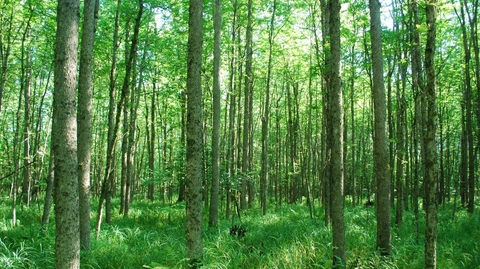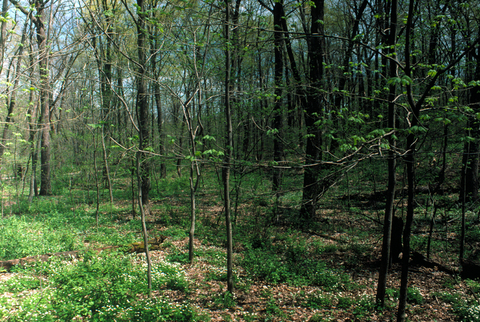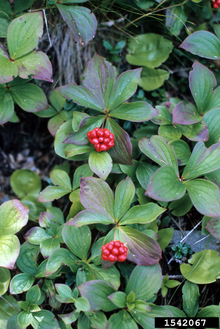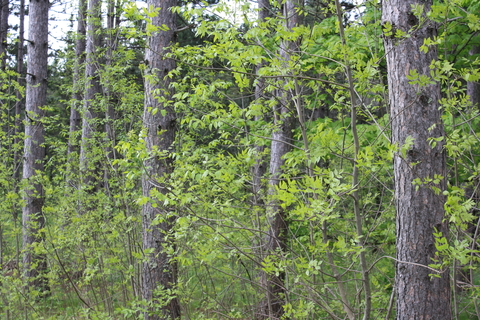Quick facts
-
All ash trees are susceptible to emerald ash borer (EAB).
-
The most common ash species in Minnesota are black ash (Fraxinus nigra), white ash (Fraxinus americana) and green ash (Fraxinus pennsylvanica).
-
Choosing the right replacement tree species depends on the surrounding plant community.
-
Disease-resistant elms are commonly-recommended to replace ash.
Plant a variety of trees to avoid emerald ash borer attack
All Minnesota counties have at least one variety of ash, and ash is found on 4.3 million acres in the state.
The large number of ash trees in Minnesota makes the state susceptible to EAB . There are many different tree species that landowners can plant to replace ash.
Trees that are suited to the plant community and site characteristics should grow well in the same location where ash is growing.
Know your plant community to select the right species
The potential of a woodland to provide timber, wildlife habitat and recreational opportunities depends on its plant community.
A native plant community is a group of plants that interact with each other and their environment and have not been greatly altered by human activity or introduced species.
It is important for landowners to recognize Minnesota’s native plant communities when selecting replacement trees for ash.
Ash trees can be found in five native plant communities in Minnesota. These communities are ranked from driest to wettest, based on soil moisture:
Ash is very common in floodplains and wet forests. Ash is found less often in mesic hardwoods, peatlands and fire-dependent forests.
Replacement trees for each native plant community
Replacement trees for ash can be identified by studying the native plant community of the specific woodland.
For each native plant community, there are two categories of recommended tree species:
- Expert-recommended trees with proven performance in research trials.
- Expert-recommended trees, but not examined in research trials.
Minnesota faced problems with Dutch elm disease in the 1970s. But disease-resistant elm trees are a commonly-recommended replacement for ash. Before the Dutch elm disease outbreak in Minnesota, elm and ash trees were found in very similar growing conditions.
Your goals for your land and specific site conditions should be considered when selecting a replacement for ash. Foresters and other natural resource professionals can provide woodland management advice and should be consulted to make appropriate planting and land management decisions.
Floodplain forests are found on floodplains, creek bottoms and riverine terraces. These forests are flat and follow a river’s gradient. The soils in a floodplain are developed on river sediment and the surface is often “grooved” with shallow channels and levees.
- Green ash is common in all of Minnesota’s floodplains.
- Black ash is common in northern Minnesota.
- White ash is common in southern Minnesota.
- Silver maple is widespread in the canopy of floodplain forests.
Recommended replacement trees suited to floodplains
Trees with proven performance in research trials:
Northern MN
-
American elm (disease resistant)
-
Swamp white oak
Southern MN
-
American elm (disease resistant)
-
Swamp white oak
-
Hackberry
Trees not examined in research trials:
Northern MN
-
Silver maple
-
Bur oak
-
Paper birch
-
River birch
-
Basswood
-
Box elder
-
Balsam fir
Southern MN
-
Silver maple
-
Basswood
-
Black walnut
-
River birch
-
Bitternut hickory
-
Box elder
-
Rock elm
-
Balsam fir
Wet forests are commonly found in narrow zones along the margins of lakes, rivers and peatlands. They are also found in shallow depressions or other landforms where the water table is within reach of plant roots.
Wet forests have varying soil moisture, depending on the season. Groundwater is at its peak in the spring and reduces throughout the growing season.
- Black ash is common in wet forest communities.
- Lesser amounts of green ash are found in wet forests.
- Northern white cedar, American elm, red maple and balsam fir are also common in the canopy of wet forests.
Recommended replacement trees suited to wet forests
Trees with proven performance in research trials:
Northern MN
- American elm (disease resistant)
- Balsam poplar
- Northern white cedar
Southern MN
-
American elm (disease resistant)
Trees not examined in research trials:
Northern MN
-
Silver maple
- Balsam fir
Southern MN
- Silver maple
- Basswood
- Black walnut
- River birch
- Bitternut hickory
- Box elder
- Rock elm
- Balsam fir
Mesic hardwood forests occur on upland sites with soils that retain water. These forests have continuous, often dense, canopies of deciduous trees with plenty of water and nutrients. The growth of trees is often limited by a lack of sunlight in the dense canopies of these forests.
- Mesic hardwood forests are typically dominated by hardwood species other than ash.
- Common species include sugar maple, basswood, ironwood, northern red oak, red maple, paper birch, yellow birch and quaking aspen.
- Approximately 10 percent of trees are ash. White ash is the most common ash species in these forests.
Recommended replacement trees suited to mesic hardwood forests
Trees with proven performance in research trials:
Northern MN
-
American elm (disease resistant)
-
Northern white cedar
Southern MN
- American elm (disease resistant)
Trees not examined in research trials:
Northern MN
- Bur oak
- Paper birch
- Basswood
- Northern red oak
- Quaking aspen
- Big-toothed aspen
- Sugar maple
- Eastern white pine
- White spruce
Southern MN
- Bur oak
- White oak
- Northern red oak
- Sugar maple
- Bitternut hickory
- Shagbark hickory
- Black cherry
- Black walnut
Forested rich peatlands are found on organic soils that contain actively forming peat. They are continuously waterlogged, with acidic soils and low nutrient availability.
- Forested rich peatlands have a large number of conifers and small amounts of ash.
- Species like black spruce, tamarack, northern white cedar and balsam fir are common overstory trees.
- Ash trees (usually black ash) will only grow in conditions where the peat is thin enough so that the roots of the ash tree can reach the mineral soil.
Because ash is not common in peatlands, this plant community will not be affected by EAB as much as the others.
Recommended replacement trees suited to peatlands
Trees with proven performance in research trials:
- American elm (disease resistant)
- Northern white cedar
Trees not examined in research trials:
- Paper birch
- Balsam fir
- White spruce
- Eastern white pine
Wildfires influence the development of fire-dependent plant communities. Fire causes species to regenerate and release nutrients that become available for tree growth.
Fire-dependent forests are some of the driest forests where trees can survive and thrive. These forests have limited nutrients available for trees to grow.
-
Jack pine, red pine, eastern white pine and quaking aspen are common overstory trees in fire-dependent forests.
-
Green ash is the most frequent ash species found in these forests, but in small amounts.
Because ash is not adapted to fire and is not common in fire-dependent forests, this plant community will not be affected by EAB as much as the others.
Recommended replacement trees suited to fire-dependent forests
Trees not examined in research trials:
Northern MN
- Jack pine
- Eastern white pine
- Red pine
- Northern pin oak
- Northern red oak
- Bur oak
- White oak
- Paper birch
Southern MN
- Jack pine
- Eastern white pine
- Northern pin oak
- Northern red oak
- Black oak
- Bur oak
- White oak
- Shagbark hickory
- Black cherry
- Big-toothed aspen
D’Amato, A.W., Palik, B.J., Slesak, R.A., Edge, G., Matula, C. & Bronson, D.R. 2018. Evaluating adaptive management options for black ash forests in the face of emerald ash borer invasion. Forests 9: 348.
Looney, C.E., D’Amato, A.W., Palik, B.J., & Slesak, R.A. (2015). Overstory treatment and planting season affect survival of replacement tree species in emerald ash borer threatened Fraxinus nigra forests in Minnesota, USA. Canadian Journal of Forest Research 45: 1728-1738.
University of Minnesota Extension. 2019. Ash Management Guidelines for Woodland Owners. University of Minnesota. St. Paul, MN, 68 p.
Reviewed in 2019






